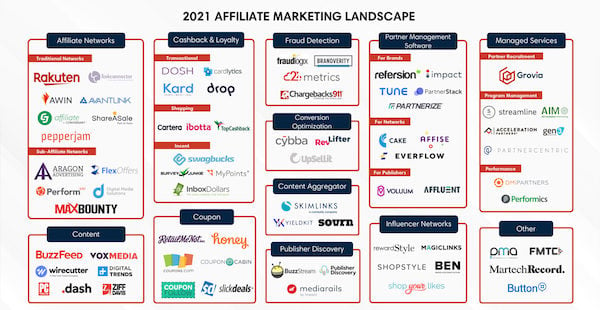So few SaaS companies understand affiliate marketing, let alone how to build an effective affiliate marketing program. When done right, affiliate marketing can be an incredible go-to-market strategy and revenue generator. Companies like Monday.com, for example, are known for this.
In the context of SaaS (software as a service), affiliate marketing is a strategy that leverages other people’s or company’s audiences to promote your product. These are your affiliates. When someone referred by an affiliate subscribes to your product, the affiliate gets a commission in return.
Here’s what we'll cover in this post:
- How to know you're ready to start an affiliate marketing program
- 8 great places to find your affiliates
- How to find good affiliates and avoid the bad
- 3 ways to reward affiliates + which way is best
- How to make it super easy for affiliates to promote your product
- Which affiliate marketing software to use to track your affiliates
- Who should manage your affiliate program
- Top 3 do’s and don'ts of maintaining good affiliate relationships
How to know you're ready to start an affiliate marketing program
While there is no definitive rule, there are three things you should have in place — at a bare minimum — before starting an affiliate program:
1. High-converting sales funnel
You must have a product that reliably converts. Conversions don't need to result in a paying customer. For example, a conversion could be a freemium or trial signup. But no matter how you define it, when affiliates send traffic your way, if your conversion rate is not significant enough to make it worthwhile for them, your affiliate program will be dead on arrival.

2. Product-market fit
In a nutshell, product market fit means you have the right product for the right customer. If you don’t clearly understand who your best customers are, you will not be able to identify the right affiliates to promote your product to the right audience.
3. Time and dedication
Affiliate partners are in it for the long-term. Their goal is to develop an ever-growing source of passive income. If you are not willing to put in the time and effort it takes to nurture those relationships and build up a program over time, affiliate marketing is probably not the right strategy for you.
8 great places to find your affiliates
Once you are ready to start your affiliate marketing program, it’s time to start finding affiliates. Here are 8 great places to look:
1. Your customers
Your customers are going to be your best source of affiliates. A great way to find potential affiliates from among them is to filter your customer list in a CRM like Hubspot or PipeDrive by whatever success metric you deem important. This will give you a list of top customers to invite to participate in your program.
2. Blogs and review sites
Find SEO-focused bloggers and websites that promote and review software providers and reach out to them to see if they will do the same for you.
3. Influencers and content creators
Connect with influential entrepreneurs, from podcasters to industry thought leaders, whose audience matches your ICP and then find ways to help them grow their business that are mutually beneficial. For example, look for gaps in their content marketing and create new content related to your product that fills those gaps. Let them use what you create as a lead magnet and distribute it to their audience on social media or through email marketing to drive traffic and new customers to your platform.
4. Communities and associations
Work with relevant online communities and professional associations. For example, you could contact the owners of Facebook groups to which your target audience belongs and ask for a pinned post in exchange for a small monthly payment and an affiliate link.
5. PPC affiliates
PPC affiliates run ads to promote and sell your product. If you choose to go this route, be sure to work with reputable affiliates who will not try and game the system by bidding against your product name, for example, and driving up your own ad prices.
6. Media sites
Media sites who publish content for the industries you target can also make good affiliates. Sites like HARO let you make yourself available as a source to journalists which is how you can make your first connection with them.
7. Brand to brand partnerships
If your ideal customers and values align with other brands and products, reach out to them to form partnerships. Work together to create co-marketing campaigns, joint webinars, case studies of shared customers, and more — efforts that are a win for everyone involved.
8. Affiliate networks
There are existing affiliate networks you can tap into. They often have a wide reach and low upfront costs, but there is a much higher potential for spam affiliates.
How to find good affiliates and avoid the bad
One of the challenges of building a strong SaaS affiliate marketing program is finding the right affiliates to work with, the ones who will consistently deliver the best results.
Here are three telltale signs of a good affiliate:
- They are already having success with your product.
- They have access to your target audience.
- They have experience promoting SaaS products.
To avoid bad affiliates, make sure you have an application process to vet them. Check out their websites, the communities they belong to, see how their content performs in search engine results, and ask how they plan to promote your product. Make sure your interests are truly aligned.
3 ways to reward affiliates + which way is best
There are a few different ways you can reward affiliates for promoting your product — one of which is nearly always the best way to go if you want to attract top affiliates.
But before you decide which commission model to follow, be sure to look at what your competitors are doing. You will likely need to match or beat them in terms of the incentives they offer if you want to compete. It’s also a necessary exercise to go through all of your expenses to calculate the absolute maximum you can actually afford to pay that will not wreck your bottom line.
1. Recurring commission
80% of SaaS affiliate programs pay recurring commissions to their affiliates. Since this is now considered the norm, it is generally the best way to attract the best affiliates. Though it might seem like too much to offer commissions on an ongoing basis for the life of a referred customer, as long as you set the right commission rate, it will always be worthwhile. In general, your commission should be about one-third of your CAC and have a 90-day cookie window for attribution.
2. Cost per lead
In the cost per lead model, you pay a set fee to an affiliate for every lead they refer. For example, in a freemium product where the user may never choose to upgrade to a paid subscription, a lead might be considered someone who signs up for the product and stays active for at least 30 days.
3. Bounties
Bounties are where affiliates are paid a one-time fee for every paying customer they send to you. Because it is a one-time thing, commission rates for bounties tend to be very high, like 100% or more. In this model, there is usually a minimum customer retention period before the affiliate gets paid.
Interested in becoming an eWebinar affiliate?
If so, first check out our 20-minute on-demand product demo. Then, learn about what we offer in our affiliate program and apply today!
How to make it super easy for affiliates to promote your product
When you onboard a new affiliate, you need to make it as easy as possible for them to successfully promote your product from the get go. Here are some of the guidelines and marketing materials you should be able to provide them with:
- Affiliate handbook
- Email templates of onboarding sequences
- Brand/media kit
- Terms and conditions of your referral program
- Pre-written social, blog, and landing page copy
- Video testimonials and case studies

Which affiliate marketing software to use to track your affiliates
Affiliate marketing tools will track affiliate conversions for you using a unique referral link. The software’s functionality will also ensure affiliates are only credited for referrals that happen during the specified attribution window (using cookie duration) and help you manage payouts.
Paddy recommends two affiliate marketing platforms, which you can learn about on their websites. They are:
DISCLOSURE: The links above are not affiliate links. No one will be rewarded for subsequent purchases.
Who should manage your affiliate program
Once you have decided to create your SaaS affiliate program, you will need to decide who will be managing it. You have 4 options available:
1. Do nothing
This isn't really an option, but there are hundreds of SaaS companies that try this and expect magic to happen. This is a recipe for failure, so don't do it.
2. Hire an experienced affiliate manager
Look for someone with 3+ years of experience specifically in SaaS affiliate programs. The more experience they have, the more expensive they will be to hire.
3. Outsource an agency or consultant
Marketing agencies are the quickest way to get the program off the ground. They have a little black book of affiliate partners that might be a good fit for your brand. Make sure they have experience in SaaS affiliate program management and recruitment of content partners.
Exploring a B2B SaaS inbound marketing agency could simplify your program launch. With their network of affiliate partners, ensure they excel in SaaS affiliate program management and content partner recruitment for effective collaboration.
4. Hire a junior marketer and train them properly
This is my favorite option. You can hire a freelance marketer or smart junior marketer and send them through an affiliate manager training course that teaches industry best practices. This lets you bring those skills in-house and empowers the business to run the affiliate program internally.
Top 3 do’s and don'ts of maintaining good affiliate relationships
To round out this post, here are the top three do’s and don’ts of maintaining good relationships with your affiliates. They come from hard-won expertise, so you can avoid having to learn these lessons yourself by trial and error.
DO’s
1. Communicate frequently with your affiliates
Make sure your affiliates are always in the know about product updates, new digital marketing material, and anything else that might affect their ability to bring you sales. Don’t be afraid to over communicate.
2. Create custom content where possible
Content specifically created for the audiences of key affiliates will pay huge dividends if it is relevant, valuable, and fills a need for your affiliates that they would not have been able to themselves.
3. Track and optimize your funnel performance
If affiliates are sending you the right people but those leads are not converting, check to see if there are any barriers, like a bad checkout experience, that might be interfering with your funnel performance and eliminate them.
DON’Ts
1. Ask for freebies
Unless it is from someone with whom you have a very well-developed relationship and you only do it infrequently, asking for freebies from affiliates is a quick way to turn them off and chase them away. Everything should be a win-win, not just a win for you.
2. Pay late
Don’t pay your affiliates late. This is the golden rule.
3. Set and forget
Don’t expect you’ll be able to set up your affiliate program and that’s it, you’re done. Affiliate relationships need love and attention. Only continuous effort will yield real, sustainable results.
Conclusion
We hope this post has been helpful in giving you a high-level overview of how to start an affiliate marketing program for your SaaS business. By now, you should have some idea of whether or not an affiliate program is right for you, the kind of affiliates you should look to partner with, the affiliate commission model you wish to follow, and how to go about getting your program up and running. Best of luck!
eWebinar lets you turn any video into an interactive webinar that can be put on autopilot by setting it on a recurring schedule or by making it available on demand. If you are interested in scaling your product demos and customer onboarding — with a personal touch! — through webinar automation, sign up for a free trial of eWebinar today.








